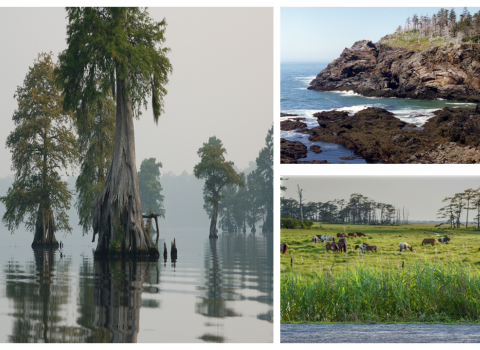Federal and state agencies from the U.S. and Canada have signed a statement of cooperation with the Passamaquoddy Tribe and the Peskotomuhkati Nation at Skutik committing to a partnership dedicated to restoring the water quality and wildlife habitat of the St. Croix River.
East of the Great Lakes, along the border of Canada and the United States, this stunning 62-mile river is the largest stretch of freshwater along the northern border of the United States. The St. Croix River, originally named the Skutik by the Passamaquoddy people, sustains more than 60 species of fish, including spawning blueback river herring and sea-run alewives.
The St. Croix watershed is a source of sustenance and culture for the Passamaquoddy Tribe at Indian Township, the Passamaquoddy Tribe at Pleasant Point, and the Peskotomuhkati Nation at Skutik. Historically, the watershed was a perpetually productive seasonal source of food. From caribou to clams, this vast river supported the wildlife that in turn sustained indigenous communities.
With the onset of colonial encroachment, however, this watershed was targeted for its lumber. To capitalize on the resources found there, dams were built to modify the flow of the St. Croix and its tributaries.
Today, the river remains fragmented, disrupting fish passage fish passage
Fish passage is the ability of fish or other aquatic species to move freely throughout their life to find food, reproduce, and complete their natural migration cycles. Millions of barriers to fish passage across the country are fragmenting habitat and leading to species declines. The U.S. Fish and Wildlife Service's National Fish Passage Program is working to reconnect watersheds to benefit both wildlife and people.
Learn more about fish passage , reducing water quality, and risking the health of both the people and local economies that rely on it. Reconnecting the watershed would not only greatly improve water quality but also support the largest sea-run alewife migration in the United States.
The newly signed agreement expands upon a pact originally developed in 2013. The Peskotomuhkati Nation at Skutik (New Brunswick), the Maine Department of Marine Resources, Fisheries and Oceans Canada, and the U.S. Department of Agriculture’s (USDA’s) Natural Resources Conservation Service will now join the Wabanaki Tribes of Maine, the U.S. Environmental Protection Agency, the U.S. Fish and Wildlife Service (USFWS), the National Oceanic and Atmospheric Administration’s (NOAA’s) National Marine Fisheries Service, and the U.S. Bureau of Indian Affairs in the effort to revive the St. Croix River.
The signing ceremony was held at the Wabanaki Cultural Center and Museum overlooking the St. Croix River. Leadership from each Tribe and organization gathered virtually and in-person to commemorate this historic partnership.
“Those who gathered here on the banks of the Skutik stood on the precipice of the future,” said USFWS Assistant Regional Director of Fish and Aquatic Conservation Rick Jacobson. “A future teaming with tens of millions of returning river herring. The future that this partnership will build.”
Said USFWS Northeast Regional Director Wendi Weber, “We are honored to participate in this growing collaboration of Indigenous partners, as well as the State of Maine and federal agencies on both sides of the international boundary, as we work together on shared objectives for native fish and the communities that depend on them.”
This partnership builds upon the Biden administration’s commitment to collaborative conservation. Birds, fish, waterways, and wildlife are not bound to the lines on a map. With so many agencies and organizations committed to conservation, it is easy to get caught up in our own initiatives and forget the wild world we protect is equally valued by all who share it.
Said USFWS Tribal Liaison Tim Binzen, “This partnership means that the Tribes’ rights, sovereignty, culture, and interests are being acknowledged and respected by federal agencies on both sides of the international boundary, and by the State of Maine. There is hope on all sides that we are entering a new era of cooperation that will result in substantial restoration successes.”
By committing to cooperation and developing a community of St. Croix stewards, this momentous agreement pools the knowledge and resources of many passionate partners to give the river the best chance at restoration.






